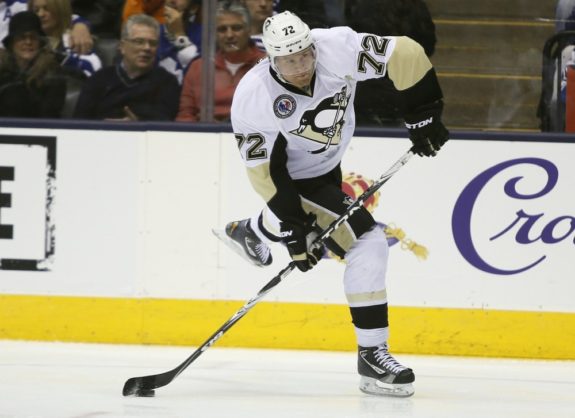As hockey fans, we are enchanted when players and goaltenders are left flailing and rendered powerless. When Evgeni Malkin floats past defenders and deposits the puck in the back of the net, it is cinematic. When Sidney Crosby bounces off coverage and lays the puck on his teammate’s stick, it is grace epitomized. Phil Kessel’s slackened posture at the faceoff dot and self-assured stride with the puck belie the blistering snap shot he unleashes when he likes his scoring angle. The Penguins are dynamic and their players entertain in various ways.
Patric Hornqvist is not a superstar, but he is arguably one of Pittsburgh’s most valuable forwards. On June 17, 2014, the Penguins traded James Neal, one of the NHL’s most gifted goal scorers, for Hornqvist, a player who does not need the puck to be effective and who has been instrumental in the Penguins’ consecutive Cup victories.
Related: Penguins Need Another Youth Movement
The Golden Goal
In Game 6 of the Cup final, when teammate Justin Schultz stroked a slap shot to create a carom, it was Hornqvist who crept behind the Predators’ Roman Josi and Ryan Ellis. Hornqvist was left alone with a bouncing puck, and he managed to corral the ricochet and direct the puck off Pekka Rinne’s back to win the game – and the Cup. It took tremendous agility to spin away from Rinne and seize the puck to bunt it onto Rinne’s back.
In fact, it was fitting that the Penguins won on that opportunity. Schultz purposefully shot off-target to get the puck toward the net and past Predators Viktor Arvidsson and Ellis (who both attempted to block it). Part of the Pittsburgh ethos is shooting to score on the second-chance attempt, and Schultz’s vision allowed for Hornqvist to jam the puck in from along the goal line.
In general, there is too much traffic obstructing shooting and passing lanes in the current NHL, but by funneling the puck toward the net, and playing the retrieval through a follow-up shot or by a deflection, you change the course of the trajectory. The Penguins want the opposing goaltender to feel as uncomfortable as possible, and Hornqvist’s puckish antics and soft hands around the paint do just that.
Hornqvist animates the Penguins’ offense by consistently winning one-on-one battles to control the puck. It is what makes him such an outstanding complement to Crosby. Give talented people ample opportunity and the effects are deleterious for the opponent. An opposing defenseman retreats in his own zone to retrieve the puck; he hears a vibration, a steady rumble. Hornqvist will take a great angle on the forecheck, hound the opposing puck-carrier until he gains control, and then try to move the puck toward the scoring areas.
Hornqvist is cheeky in other ways, too. He specializes in the accidentally-on-purpose off-the-puck contact to open up lanes for his teammates. His methods of support come in ways other than lifting an enemy skater’s stick so Crosby can filch the puck and run.
Related: Kunitz & Hornqvist Personify Pittsburgh
Hornqvist Thrives in All Situations
His retrieval ability enriches the Penguins’ top power-play unit. Hornqvist stands in the low-slot, blocks the goaltender’s sightline and tries to deflect pucks and jam in rebounds. If the puck misses the net, Hornqvist doggedly pursues it and then passes it back to the superstars. The math is widely published on the impact of controlling the puck and increasing shot attempts. Success follows.

Coach Mike Sullivan used Hornqvist aggressively on defensive-zone starts in the 2016-17 playoffs. Hornqvist started almost 69 percent of faceoffs in the defensive zone, after starting just nearly 60 in the offensive zone in 2015-16. Sullivan recognized a different way he could use Hornqvist and wanted to harness his irreproachable skill of winning the vis-à-vis.
Hornqvist is unique – he thrives on chaos. While every player craves more space, only a few have the acumen to generate room at will. Hornqvist seeks no such comfort. His best work is with the opponent inches away from him. He thrives under duress, in the messy, welter of bodies that occupy the low-slot. His influence is in plain sight and thus more ordinary, and that makes his offense and scoring opportunities look more understated. One of the first lessons hockey players learn is to keep your stick on the ice and crash the net. Hornqvist has made a great living off of the first ten minutes of hockey camp.